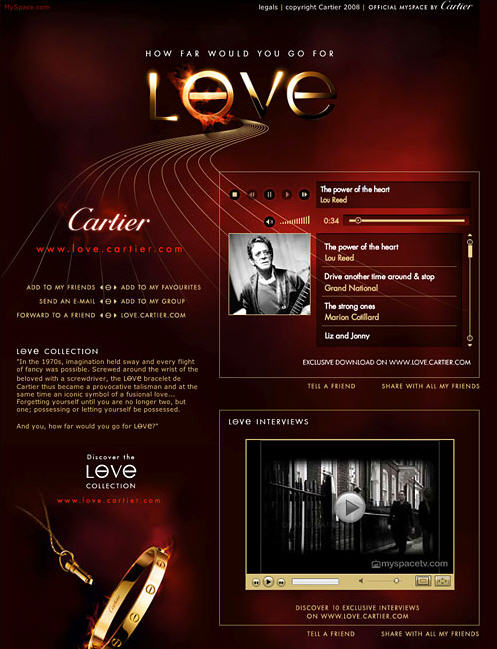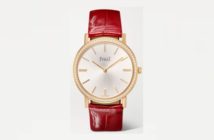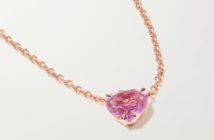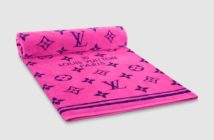
On MySpace, the social networking Web site, the rock band Panic at the Disco has 1.4 million friends. Coldplay has 467,000 friends. Paris Hilton has 178,000 friends and Madonna has 397,000.
As for Cartier, the luxury jeweler, it has more than 3,800 friends, including Sting, the band Good Charlotte and Lou Reed. And while the sincerity of these friendships is questionable — when was the last time that Eric Clapton sent Cartier a birthday card, or vice versa? — they send a message that Cartier cares about people who spend their time on MySpace.
Cartier, owned by Richemont of France, is one of the first luxury brands to hang out its shingle on a social networking site, for fairly obvious reasons. How do you market items of the you-can’t-afford-it-if-you-have-to-ask-the-price variety to a population that is heavily represented by people who make their money by baby-sitting and mowing lawns?
“To work in the luxury environment, it means being a step in advance sometimes,” Corinne Delattre, director of communications at Cartier, said. “We work with people moving fast. They use technology. They are ahead in their way of life.”
On its MySpace site (myspace.com/lovebycartier), Cartier has many friends who it hopes fit this description. Most of them are not famous, but the jeweler is counting on them nonetheless to spread the vibe through the social network and beyond.
The MySpace profile was set up to advertise jewelry in Cartier’s Love collection, but visitors can also sample music from artists like Lou Reed and Grand National, including several songs with the theme of love that were composed for Cartier. They can watch film clips with a romantic story line. And, of course, they can click on any of those friends’ pictures to visit their profiles.
The possibility of blending entertainment and marketing and spreading it through chain letter-style links has many marketers excited about social networking. But luxury brands, worried about the company they keep, have been reluctant to become involved with the likes of MySpace or Facebook. Cartier took the risk, Ms. Delattre said, because it was a “different way to talk to a young audience.”
Actually, many expensive brands have been slow to move to the Internet generally, let alone to freewheeling frontiers like social networks. Some brand owners have spent years battling eBay, the online auction site, contending that it does too little to curb sales of fakes. Others have clashed with Google over its advertising system, which has allowed rival marketers to snatch away trademarks as search keywords.
A number of fashion and luxury companies have advertised on ASmallWorld, an invitation-only social network aimed at wealthy consumers. Now some of them are getting their first exposure to mainstream, mass-market social networks. Some have “fan pages” on Facebook, which allow people to post videos of themselves wearing their favorite designer fashions, for example.
But practically anyone can set up a page on Facebook, at no cost, which demonstrates two of the biggest problems with social networking as an advertising medium. One, for the advertiser, is a lack of control over the process. The other, for the network owner, is the lack of money changing hands: if “fans” of a luxury brand voluntarily tell their friends about it, why should the brand owner spend any money to do so?
Though ad spending on MySpace has trailed expectations, the company, part of the News Corporation, thinks it has solved some of the problem, with the Cartier campaign serving as a model. MySpace requires big marketers that want to create profiles to pay for the space, though it declined to say how much Cartier was being charged for its yearlong campaign.
In return, MySpace takes steps to drive traffic to advertisers’ profiles and to ensure that the material that appears on them “respects the brand’s objectives,” as Damien Vincent, head of sales at MySpace France, put it. In the case of Cartier, that means weeding out some would-be friends. Candidates whose photos show them guzzling a beer at a party, for instance, are unlikely to make the cut, Mr. Vincent said.
MySpace is eager to show that its audience extends beyond teenagers looking to kill time after school. Eighty-five percent of American users are over 18, it says. “I think there’s a huge potential market for luxury advertisers,” said Jamie Kantrowitz, senior vice president for content and marketing at MySpace International.
Ben Hourahine, futures editor at the London branch of the advertising agency Leo Burnett, said the use of social networks was appropriate at a time when consumer attitudes about luxury were changing. In a recent survey of American consumers by the agency, only 7 percent said they thought “luxury” meant being part of an exclusive club.
“Luxury brands in the past had this unattainable aspect to them,” he said. “Now they realize they need to connect and communicate with people.”



